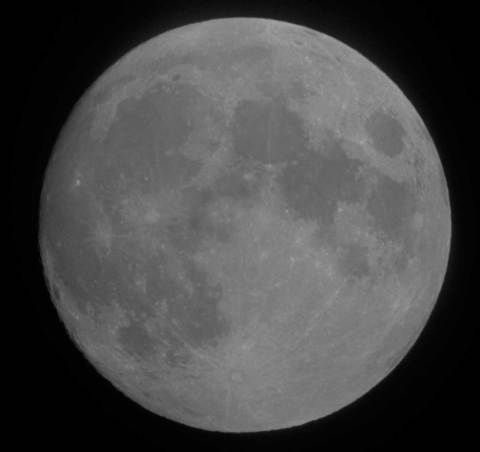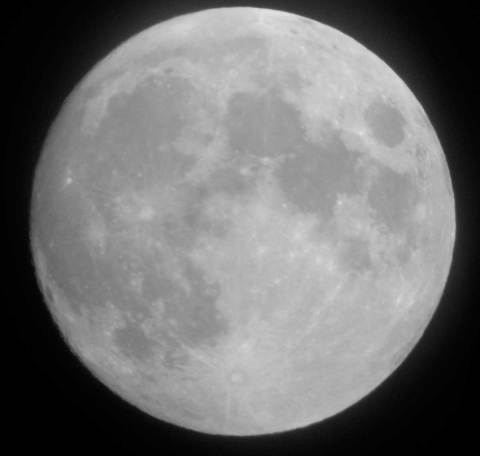In honor of today’s lunar eclipse on the far side of the Earth, here is last night’s “full” moon shot, taken about 17 hours before official full.
I learned a few things while making this image last night.
One is, no matter how intense the storm, there’s always a chance that things will clear up. We had a little thunderstorm roll through the area around 8 pm, with almost continuous lightning on the leading edge, wind gusts of up to 30 mph, and nearly half an inch of rain. But it was traveling around 25 mph, so by the time the moon was high enough in the sky to take pictures of, only that tiny little area in the southwest that actually contained the moon had any hint of clouds. And sure enough, that too cleared up and the moon was all alone in the sky.
So I took about 40 images, varying my zoom, ISO, aperture, and shutter speed settings to make sure I got a good shot. And then, right at the end, I decided to do some visual observing. And when I did that, I discovered that the image in the eyepiece was pretty blurry. Now, I know my eyes are getting older (yours are, too), and I know that I have a hard time focusing “late” at night (it was after 11 p.m. by now). But I was still surprised at how different the focal plane of the system is, depending on whether or not the camera is attached.
So I took a few shots at “eyepiece” focus, since all of my previous shots had been done on “camera” focus (looking at the screen on the back of my camera).
And when I came inside I learned that eyepiece focus, at least in my set-up, is much better than camera focus. I need to focus through the eyepiece first, then just put the camera in place and click away. For years I’d been trying the “standard” digiscoping technique of focusing through the eyepiece and then fine-tuning it with the lens on max zoom, trying to get the best possible resolution in the camera screen. But that doesn’t work unless you’re also taking the picture at max zoom, at least with this set-up. Something about the way the lens and the eyepiece interact makes it so that what looks like good focus at max zoom is no longer good focus when you’ve got the entire moon in the image. Here’s one of the shots using best camera focus; see how much blurrier it is?
And so, despite their blurriness (an unrelated effect of uncontrolled dew on the lens), a few shots snapped out of idle curiosity before heading inside for the night turned out to be the most useful shots of the session.
And a third thing I learned is that June’s moon is known as Flower Moon in the “English” scheme, Strawberry Moon in the “Native American” scheme, Rose Moon in the “Colonial American” scheme, Moon of Horses in Celtic, Dyad Moon in Wiccan (Medieval), and Planting Moon in Wiccan (Neo Pagan). All of these names are from the MoonPhase iPad app.



